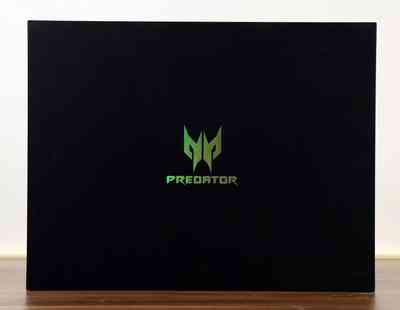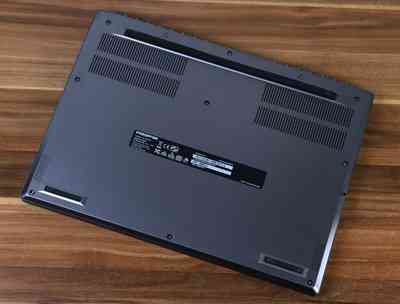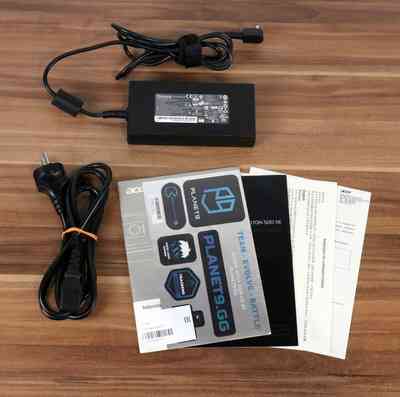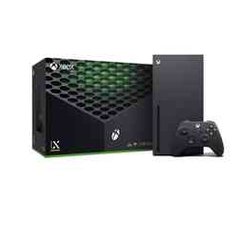In recent years, manufacturers of gaming laptops have become more likely to create products in a more restrained minimalist style. Given the fact that top models now cost over 200 thousand rubles, it is not surprising. Not everyone can afford such a device, and those who can hardly experience great joy from colored Christmas tree garlands and bright plastic. For such users, there is an offer from Acer, which at the end of last year launched its new gaming laptop Predator Triton 500 SE. It is about him that we will discuss today in our review.
EQUIPMENT, APPEARANCE AND CONNECTORS
The laptop comes in a black cardboard package with colorful printing in the style of predator gaming devices with inscriptions in blue tones and an image of the laptop itself. On top, where the box opens, there is a plastic handle for convenient transportation of the computer.
Inside, the laptop and accessories are traditionally laid out in two smaller boxes and do not hang out thanks to the forms of foamed polyethylene. In the long black box, buyers will find a fairly large 230W power supply and a standard computer power cable. The laptop itself is located in a large flat box. Under it you can also find an envelope with various documentation, a set of stickers and a warranty.
Predator Triton 500 SE looks as minimalistic as possible. Its body is almost entirely made of metal, painted in silver color. The only detail adorning the laptop cover is a small predator emblem with a polished background. There are no rainbow body lights and bright details. The gaming solution in a laptop is only given out by the shape of a plastic grille on the rear end, from where part of the heat is removed.
The thickness of the laptop case in the widest part, excluding the rubber legs, is 20 mm, the length is 35.8 cm, and the width is 26.5 cm. The weight of the test sample was 2 kg and 401 grams, which is quite normal for a gaming laptop with a powerful filling and a 16-inch screen. However, it is worth remembering that the kit also includes a large power supply, which with a cable weighs an additional 0.9 kg, which eventually translates into 3.3 kg of weight in your backpack. This is quite a lot if you plan to move around with him often. Although no one has canceled the possibility of recharging the device through Type-C connectors from more compact units with less power. If you don't need maximum performance on trips, then this will greatly facilitate your luggage.
Since we have touched on the topic of connectors, it's worth talking about what the Predator Triton 500 SE is equipped with. Here the model offers the maximum richness and variety of interfaces. On the left side, in addition to the side ventilation and the connector for the complete unit, the manufacturer installed an Ethernet connector with a bandwidth of 2.5 Gbit/s, a USB 3.1 port of the 2nd generation with the function of charging external devices, a Thunderbolt 4 interface port and a 3.5 mm audio connector for connecting a headset. On the right side there is also a vent and one more Thunderbolt port for 4 and for USB-A 3.1 of the 2nd generation, as well as a Kensington lock for theft protection, a card reader for SD cards and an HDMI 2.1 connector for connecting to monitors and televisions with 4K resolution with a refresh rate of 120 Hz.
The end of the lid has a beveled shape and allows you to catch on the lid to open the laptop. The hinge design in combination with the weight of the device makes it easy to open the laptop both 90 degrees and a maximum of 180 degrees. The frames around the screen are fairly standard. The sides are only 5 mm wide, the top is 7 mm, and the bottom, with the logo, as usual, the largest is 14 mm. Above the screen there is a pair of microphones, a webcam and a 720p resolution, which is suitable for video calls.

SCREEN, USABILITY AND SOUND
"BOE Technology". This 8-bit IPS matrix with a resolution contributes to the flawless transmission of the smallest details (2560 by 1600 pixels) and a refresh rate of 165 Hz. The response time from gray to gray is 3 ms. The maximum brightness is 500 nits, and the contrast is 1200:1. With such brightness, this laptop can be used outdoors in direct sunlight. To prevent image breaks and distortions in dynamic scenes, the laptop screen is equipped with NVIDIA G-Sync adaptive frame synchronization technologies.
The screen supports about 100% of the sRGB color coverage, so it is also suitable for working with graphics. "Acer Quick Access". The viewing angles correspond to the standard 178 degrees for IPS displays. A glow effect is noticeable on a static black field at an angle.
Below the screen and above the keyboard block, the manufacturer placed a perforation in the form of quadrangles, among which he placed not the power button, but the Turbo button for quickly switching the laptop to maximum performance mode. The button is highlighted when this mode is activated. In turn, the power key is located in the upper right corner of the keyboard block next to the Delete button. Even if you accidentally press it during use, you will not do anything, since it is triggered in the on state only after being clamped for a few seconds. It can also be reconfigured to turn off the display or put the laptop to sleep/hibernation via the Acer Quick Access app.

The keyboard here is of an island type, recessed into the body of the device and without a digital block. However, some of the letter keys have the functions of a digital block and are activated by the combination FN + number lock. In addition, the manufacturer placed four additional buttons on the right side under the power button, responsible for volume control, player control, as well as quick access to the Predator Sense application. In addition, the keyboard is equipped with a 3-zone RGB backlight. The buttons have four brightness levels, and it can be adjusted by alternately pressing the combination FN + F4. The illumination of the keys is uniform, does not blind at night.
The touch panel here is not very large. Its dimensions are 107 by 79 mm. It is covered with protective glass Corning Gorilla Glass. Fingers slide easily on the touchpad and we have no complaints about its work. In the upper left corner there is a fingerprint scanner, which is easy to configure, but sometimes it does not recognize the user's finger the first time.
For the sound on this solution, two speakers from below are responsible for 2 watts each with declared DTS support:X Ultra, which adds a bit of volume when choosing a profile for the corresponding content. The volume reserve of the speakers is average, it is enough for a small room. Bass is not enough for them, and high and medium sound flat. For games, especially taking into account the noise of the cooling system, it is better to use an additional headset. In general, there are enough speakers when watching videos on the Internet.
FILLING, BATTERY, OPERATION AND TESTS
The Predator Triton 500 SE received by us for the test is built on the basis of a 10-nanometer Intel Core i9-11900H processor operating at a frequency of 2.5 GHz. The processor is 8-core and runs in 16 threads, with 24 MB of third-level cache, and the maximum frequency is 4.9 GHz. The CPU's TDP is 45 watts. There are two video adapters in the laptop: an Intel UHD accelerator built into the CPU and a discrete NVIDIA GeForce RTX 3080 Laptop card with 8GB of GDDR6 and 110W TGP memory.
Cooling of the internal components is provided by a cooling system of four copper heat pipes, which are responsible for heat removal from the CPU, GPU and other connecting components on the board, as well as as many as three fans with fifth-generation AeroBlade 3D impellers with a blade thickness of only 0.08 mm, which allowed the manufacturer to increase the number of blades on each impeller to 89.
The laptop has 32 GB DDR4-3200 MHz memory from Kingston, working in two-channel mode. It is not soldered on the board, installed in two corresponding slots and, if absolutely necessary, can be expanded to 64 GB. The role of internal drives in the test sample was performed by two NVMe SSDs for 1 TB from Samsung. It is worth noting that in order to expand and replace components in a laptop, you will have to disassemble the laptop completely, since the RAM and storage slots are located on the keyboard side.
The laptop provides the user with both wired and wireless internet access. For wired connection, an Intel Killer Ethernet E3100 network controller with a transmission rate of 2.5 Gbit/s via an Ethernet port is installed here. Wireless communication is provided by the dual-band adapter Killer Wi-Fi 6 AX1650i (802.11ax), which also supports Bluetooth connection version 5.2. It is installed in a separate slot M.2 on the laptop board and, if necessary, it will be easy to replace it, since the slot is located on the side of the bottom cover of the laptop. We connected the laptop wirelessly to the Wi-Fi 6 router from Huawei and without any problems got a speed of over 500 Mbit/s for both loading and unloading. There were no problems with connecting to the router during testing, and the loading of games was fast and stable.
The laptop comes with a 4-cell lithium-ion battery with a capacity of 6578 mAh, 99 Wh, 15.2V. The full charge of this battery lasts for 6-7 hours in the default mode for everyday use (surfing the Internet, working with documents, watching videos and listening to music) with 50% screen brightness. For time-consuming tasks, the laptop keeps a charge for about 1.5-2 hours. With maximum performance, like all gaming laptops, the system works only when the power is connected.
To control the operating modes of the laptop, a proprietary PredatorSence application is installed on it, in which four options are available to the user:
- Quiet - reduces the noise level of the cooling system as much as possible and is used for simple tasks like surfing the Internet.
- By default– it is for standard everyday use, such as office work and content viewing.
- Extreme – for games and time-consuming tasks. In this mode, the factory overclocking of the processor is activated and the operation of the fans is automatically regulated.
- Turbo – for games at maximum performance. In this mode, the maximum performance of the laptop is used, and the cooling system always works at maximum speed, which results in high noise indicators.
- The application also allows you to control the cooling system separately. By default, it is adjusted automatically, but you can also switch to maximum operation or adjust each of the three fans individually. Unlike the operating modes, fan adjustment is also available when the laptop is running on battery power. Other features of the application include the ability to monitor the status of components and the network, as well as add profiles for certain games.
In the standard (default) mode, NWiNFO64 shows the following average temperature values:
- CPU – 45 °C
- Graphics core – 42 °C
- NVIDIA GeForce RTX 3080 Laptop - not active
- SAMSUNG MZVL21T0HCLR-00B07 (S63GNE0NC00735) – 43 °C
- SAMSUNG MZVL21T0HCLR-00B07 (S63GNE0NC00722) — 50 °C
- Two installed PCIe Gen 4 drives are combined in RAID0 and demonstrate excellent results during tests. The disk speed in Crystal Disk Mark was 11990 MB/s for reading and 10057 MB/s for writing. The AS SDD test, as usual, shows more modest results - 8386 MB/s for reading and 7300 mb/s for writing. The maximum temperature of the SSD under load reached 63 °C.
By tradition, we tested the processor performance in the Cinebench R23 benchmark test in the factory overclocking mode (Turbo), in which the cooling system fans are running at full capacity. In the Cinebench R23 multithreaded test, the processor was able to score 11683 points. The average frequency was kept at around 3.9 GHz, and the maximum temperature was recorded at 101 °C. This is the only test where the processor reached the maximum temperature values. In a single-threaded CPU, I was able to earn 1446 points at an average operating frequency of 4.2 GHz. Here, the maximum CPU temperature did not exceed 71 degrees. In games and game tests, the maximum temperature on average was kept at around 80-90 degrees.
The RTX 3080 Laptop performs well in graphical tests. The maximum GPU temperature in both games is kept on average at around 76-78 degrees. The metal case heats up quite strongly. The surface of the keyboard is heated most in the middle and on the right side. In the area of the WASD buttons, the keyboard becomes warm and does not interfere with the game.

As for the noise indicators, the laptop is practically not audible in quiet mode at a room noise level of 20-30 dB. Under heavy loads, powerful cooling begins to work and the device becomes noisy. You can turn the fans of the device to maximum speed in the PredatorSense application, as well as if you switch to Turbo mode. The average noise level under load is 48-52 db, which is slightly higher than standard indicators for gaming laptops.
In synthetic tests, the laptop was tested in turbo mode with power connected, mainly in Full HD and QHD resolutions, as well as in similar resolutions, taking into account the 16:10 screen ratio:
- In the benchmark Superposition test on the Unigine 2 engine in 1080p mode at extreme settings, the system showed from 38 to 61 frames, while in the optimized 4K mode, the GPU was able to show from 55 to 82 frames.
- In the Chinese Boundary test with ray tracing at 1600p resolution, the laptop was able to get an average of 102 frames per second with DLSS in ultra-performance mode. In quality mode, with the same settings, the average FPS was 44.
- In the Final Fantasy XV Windows Edition benchmark, a laptop with high graphics settings in Full HD resolution was able to earn 9442 points and a performance rating of "Very high”, and in 2K - 7644 points and “High”. In 4K, he was able to earn only 4737 points, which earned him a rating of "High Enough".
- The system has also been tested in the in-game tests Forza Horizon 4, Forza Horizon 5 and Shadow of the Tomb Raider in resolution WUXGA (1920x1200 and WQXGA (1000000):
Forza Horizon 4, which brought a change of seasons to the series, was able to produce an average of 122 FPS at 1200p and 98 FPS at 1600p at maximum graphics settings.
In the fresh Forza Horizon 5, which moved the Horizon festival to the territory of hot Mexico, everything is expected to be lower. At the maximum graphics settings in the game, it was possible to get an average of 77 FPS in WUXGA resolution and 66 FPS in 1600p.
The in-game benchmark Shadow of the Tomb Raider was launched on similar settings, as well as with ray tracing and DLSS in “Quality" mode. So, in 1200p, we managed to get an average performance of 108 FPS and 91 FPS in 1600p.
Next, we tested the laptop for performance in WQXGA resolution (1000000) at the maximum graphics settings directly during gameplay:
- To begin with, we launched Doom Eternal on the “Absolute Nightmare" graphics settings with ray tracing and DLSS smoothing in the “Quality" mode. On average, the frame rate in this dynamic shooter at the fifth level of the "Bloody Super Nest" was kept at 91 frames per second (1% Low - 70 FPS, 0.1% Low - 59 FPS).
- The second was Control from Remedy. We launched the project at the maximum graphics settings with RTX and DLSS, and the rendering resolution is 1707x1067. With these settings, the picture on the laptop screen looked great, and the average frame rate in complex battle scenes was kept at 57 frames (1% Low - 47 FPS, 0.1% Low - 32 FPS).
- The next graphics test was Cyberpunk 2077. We tested the game at maximum settings with RTX and DLSS in performance mode and received an average of 56 frames (1% Low - 47 FPS, 0.1% Low - 41 FPS) while traveling through the Watson area by car and 51 FPS (1% Low – 43 FPS, 0.1% Low – 35 FPS) as part of the Maelstrom base in the task "Overthrow of the Maelstrom".
- At the end, we also included the Halo Infinite shooter. We launched the game campaign on very high graphics settings, and the average frame rate was 50 FPS (1% Low - 35 FPS, 0.1% Low - 25 FPS).
RESULT
Predator Triton 500 SE can be called a worthy representative of gaming laptops in a fairly thin case for its characteristics. It has a nice strict look without colorful details and at the same time a standard weight for a powerful mobile device. The productive filling combined with a good screen and a rich selection of connection interfaces allows you to use the laptop not only for games, but also for serious work tasks. Despite the powerful and noisy (at maximum rpm) cooling system, the temperature indicators are still at a high level. And this is the price that users of such devices have to pay.
The cost starts from 155 thousand rubles for models with weaker configurations - with i7-11800H and RTX3060. The price of the tested configuration, but with 64 GB of RAM starts from 291 thousand rubles.
Now there is a 10% discount on all Predator laptops in the official Acer store. To do this, you need to use the PT500SE promo code when placing an order. The promotion will last until February 23, 2022.
Author: Sergey Dyakonenko (Madnfs)


















0 Comments:
Leave a Reply